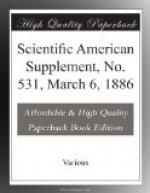On looking over the results, it is found that the red rolls contained starchy matters in abundance (in No. 4 the starch was to a large extent replaced by water), and an ash, mostly sodium chloride, introduced no doubt to assist in its preservation as well as to increase the color of the resin—a well known action of salt on vegetable reds. The cakes, which are mostly used for cheese coloring, I believe, all appeared to contain turmeric, for they gave a more or less distinct reaction with the boric acid test, and all except No. 8 contained large quantities of chalk. These results in reference to extractive, etc., reveal nothing that has not been known before. Wynter Blyth, who gives the only analyses of annatto I have been able to find, states that the composition of a fair commercial sample (which I take to mean the raw article) examined by him was as follows: water, 24.2; resin, 28.8; ash, 22.5; and extractive, 24.5; and that of an adulterated (which I take to mean a manufactured) article, water, 13.4; resin, 11.0; ash (iron, silica, chalk, alumina, and common salt), 48.3; and extractive. 27.3. If this be correct, it appears that the articles at present in the market, or at least those which have come in my way, have been wretched imitations of the genuine thing, and should, instead of being called adulterated annatto, be called something else adulterated, but not seriously, with annatto. I have it on the authority of the farmer previously referred to, that 1/4 of an ounce of No. 4 is amply sufficient to impart the desired cowslip tint to no less than 60 lb. of butter. When so little is actually required, it does not seem of very serious importance whether the adulterant or preservative be flour, chalk, or water, but it is exasperating in a very high degree to have such compounds as Nos. 3 and 6 palmed off as decent things when even Nos. 1, 2, and 5 have been rejected by dairymen as useless for the purpose. In conclusion, I may be permitted to express the hope that others may be induced to examine the annatto taken into stock more closely than I was taught to do, and had been in the habit of doing, namely, to see if it had a good consistence and an odor resembling black sugar, for if so, the quality was above suspicion.
* * * * *
JAPANESE RICE WINE AND SOJA SAUCE.
Professor P. Cohn has recently described the mode in which he has manufactured the Japanese sake or rice wine in the laboratory. The material used was “Tane Kosi,” i.e., grains of rice coated with the mycelium, conidiophores, and greenish yellow chains of conidia of Aspergillus Oryzoe. The fermentation is caused by the mycelium of this fungus before the development of the fructification. The rice is first exposed to moist air so as to change the starch into paste, and then mixed with grains of the “Tane Kosi.” The whole mass of rice becomes in a short time permeated by the soft




